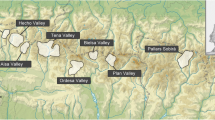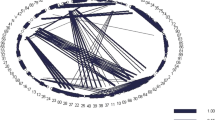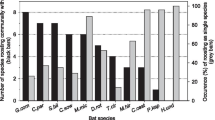Abstract
The roosting behavior of the big fruit-eating bat, Artibeus lituratus (Phyllostomidae, Stenodermatinae) in an Andean region of Venezuela is described. Sixty-four video recordings made at three separate foliage roosts during 1 year showed that group size varied between two and 14 individuals. One male was regularly observed roosting with more females than others, and this male was associated with the highest quality roost, defined here as the highest, most structurally stable, and least disturbed. Males invariably occupied exclusive roosts during the study, whereas females frequently moved among adjacent roosts. The high roost fidelity of males appears to be related to the defense of the highest quality roosts. Because females were observed roosting with each of the three males present at the study site, female groups were considered unstable. We suggest that shuttling movements of individuals may reflect a commonly observed adaptation of foliage roosting bats related to the avoidance of predators and/or parasites. The type of male–female association observed in A. lituratus is consistent with a resource defense polygyny hypothesis.
Zusammenfassung
Die Studie beschreibt Beobachtungen zum Quartiernutzungsverhalten der großen, Frucht fressenden Fledermaus Artibeus lituratus in der Andenregion Venezuelas. Vierundsechzig Videoaufnahmen von drei separaten Blattquartieren über den Zeitraum von einem Jahr zeigten, dass die Gruppengröße zwischen zwei und 14 Individuen schwankt. Das Männchen, das das qualitativ hochwertigste Quartier, d.h. das höchste, stabilste und am wenigsten gestörte Blatt, nutzte, wurde auch regelmäßig mit mehr Weibchen angetroffen als die anderen Männchen. Die Männchen nutzten ausschließlich das gleiche Blatt als Quartier, während die Weibchen häufig zwischen benachbarten Quartieren wechselten. Die hohe Quartiertreue der Männchen scheint mit der Verteidigung hochwertiger Quartiere in Zusammenhang zu stehen. Da die Weibchen mit jedem der drei Männchen des Studiengebietes zeitweise das Quartier teilten, wurden die Weibchengruppen als instabil gewertet. Wir sind der Ansicht, dass Quartierwechsel eine Anpassung Blatt bewohnender Fledermäuse ist, um Raubfeinde und Parasitenbefall zu vermeiden. Die beobachtete Männchen-Weibchen-Vergesellschaftung bei Artibeus lituratus stimmt mit der „Resource Defense Polygyny”-Hypothese” überein.
Similar content being viewed by others
References
Anthony, E.L., 1988. Age determination in bats. In: Kunz, T.H. (Ed.), Ecological and Behavioral Methods for the Study of Bats. Smithsonian Institution Press, Washington, DC, pp. 47–58.
Balasingh, J., Koilraj, J., Kunz, T.H., 1995. Tent construction by the short-nosed fruit bat Cynopterus sphinx (Chiroptera: Pteropodidae) in southern India. Ethology 100, 210–229.
Bradbury, J.W., 1977. Social organization and communication. In: Wimsatt, W.A. (Ed.), Biology of Bats, vol. III. Academic Press, New York, pp. 1–72.
Chaverri, G., Kunz, T.H., 2006. Roosting ecology of the tent-roosting bat Artibeus watsoni (Chiroptera: Phyllostomidae) in southwestern Costa Rica. Biotropica 38, 77–84.
Chaverri, G., Quirós, O.E., Gamba-Rios, M., Kunz, T.H., 2007. Ecological correlates of roost fidelity in the tent-making bat Artibeus watsoni. Ethology 113, 598–605.
Clutton-Brock, T.H., 1989. Mammalian mating systems. Proc. Roy. Soc. London B 236, 339–372.
Davis, W.B., 1984. Review of the large fruit-eating bats of the Artibeus “lituratus” complex (Chiroptera: Phyllostomidae) in middle America. Occasional Papers of the Museum, Texas Tech University, vol. 93, p. 1–16.
Emlen, S.T., Oring, L.W., 1977. Ecology, sexual selection, and the evolution of mating systems. Science 197, 215–223.
Entwistle, A.C., Racey, P.A., Speakman, J.R., 2000. Social and population structure of a gleaning bat, Plecotus auritus. J. Zool. (London) 252, 11–17.
Goymann, W., Leippert, D., Hofer, H., 2000. Sexual segregation, roosting, and social behaviour in a free-ranging colony of Indian false vampires (Megaderma lyra). Z. Säugetierkd. 65, 138–148.
Hodgkison, R., Balding, S.T., Akbar, Z., Kunz, T.H., 2003. Roosting ecology and social organization of the spotted-winged fruit bat, Balionycteris maculata (Chiroptera: Pteropodidae), in a Malaysian lowland dipterocarp forest. J. Trop. Ecol. 19, 667–676.
Kunz, T.H., 1982. Roosting ecology of bats. In: Kunz, T.H. (Ed.), Ecology of Bats. Plenum Press, New York, pp. 1–56.
Kunz, T.H., 1996. Methods of marking bats. In: Wilson, D.E., Cole, F.R., Nichols, J.D., Rudran, R., Foster, M.S. (Eds.), Measuring and Monitoring Biological Diversity. Standard Methods for Mammals. Smithsonian Institution Press, Washington, DC, pp. 304–310.
Kunz, T.H., Lumsden, L.F., 2003. Ecology of cavity and foliage roosting bats. In: Kunz, T.H., Fenton, M.B. (Eds.), Bat Ecology. University of Chicago Press, Chicago, pp. 3–89.
Kunz, T.H., McCracken, G.F., 1996. Tents and harems: apparent defence of foliage roosts by tent-making bats. J. Trop. Ecol. 12, 121–137.
Kunz, T.H., August, P.V., Burnett, C.D., 1983. Harem social organization in cave roosting Artibeus jamaicensis (Chiroptera: Phyllostomidae). Biotropica 15, 133–138.
Kunz, T.H., Fujita, M.S., Brooke, A.P., McCracken, G.F., 1994. Convergence in tent architecture and tent-making behavior among neotropical and paleotropical bats. J. Mamm. Evol. 2, 57–78.
Kunz, T.H., Wemmer, C., Hayssen, V., 1996. Sex, age and reproductive condition. In: Wilson, D.E., Cole, F.R., Nichols, J.D., Rudran, R., Foster, M.S. (Eds.), Measuring and Monitoring Biological Diversity. Standard Methods for Mammals. Smithsonian Institution Press, Washington, DC, pp. 279–290.
Lewis, S.E., 1995. Roost fidelity of bats: a review. J. Mammal. 76, 481–496.
Lewis, S.E., 1996. Low roost-site fidelity in pallid bats: associated factors and effect on group stability. Behav. Ecol. Sociobiol. 39, 335–344.
Lim, B.K., Wilson, D.E., 1993. Taxonomic status of Artibeus amplus (Chiroptera: Phyllostomidae) in northern South America. J. Mammal. 74, 763–768.
Marshall, A.G., 1982. Ecology of insects ectoparasitic on bats. In: Kunz, T.H. (Ed.), Ecology of Bats. Plenum Press, New York, pp. 369–401.
Martin, P., Bateson, P., 1993. Measuring Behaviour: An Introductory Guide, second ed. Cambridge University Press, Cambridge.
McCracken, G.F., Bradbury, J.W., 1981. Social organization and kinship in the polygynous bat Phyllostomus hastatus. Behav. Ecol. Sociobiol. 8, 11–34.
McCracken, G.F., Wilkinson, G.S., 2000. Bat mating systems. In: Crichton, E.G., Krutzsch, P.H. (Eds.), Reproductive Biology of Bats. Academic Press, Cambridge, pp. 321–362.
Morrison, D.W., 1979. Apparent male defense of tree hollows in the fruit bat, Artibeus jamaicensis. J. Mammal. 60, 11–15.
Morrison, D.W., Handley Jr., C.O., 1991. Roosting behavior. In: Handley, Jr., C.O., Wilson, D.E., Gardner, A.L. (Eds.), Demography and Natural History of the Common Fruit Bat, Artibeus jamaicensis on Barro Colorado Island, Panama. Smithsonian Institution Press, Washington, DC, pp. 131–135.
Muñoz-Romo, M., Herrera, E.A., 2003. Leaf modifying behavior in Artibeus lituratus. Acta Chiropterol. 5, 273–276.
Ortega, J., Arita, H.T., 1999. Structure and social dynamics of harem groups in Artibeus jamaicensis (Chiroptera: Phyllostomidae). J. Mammal. 80, 1173–1185.
Ortega, J., Arita, H.T., 2000. Defence of females by dominant males of Artibeus jamaicensis (Chiroptera: Phyllostomidae). Ethology 106, 395–407.
Ostfeld, R.S., 1987. On the distinction between female defense and resource defense polygyny. Oikos 48, 238–240.
Racey, P.A., 1988. Reproductive assessment in bats. In: Kunz, T.H. (Ed.), Ecological and Behavioral Methods for the Study of Bats. Smithsonian Institution Press, Washington, DC, pp. 31–45.
Sosa, M., Ramoni-Perazzi, P., 1995. Patrón reproductivo de Artibeus jamaicensis Leach, 1821 y A. lituratus (Olfers, 1818) (Chiroptera: Phyllostomidae) en una zona árida de Los Andes venezolanos. Rev. Brasil. Biol. 55, 705–713.
Stoner, K.E., 2000. Leaf selection by the tent-making bat Artibeus watsoni in Asterogyne martiana palms in southwestern Costa Rica. J. Trop. Ecol. 16, 151–157.
Storz, J.F., Bhat, H.R., Kunz, T.H., 2000a. Social structure of a polygynous tent-making bat, Cynopterus sphinx (Megachiroptera). J. Zool. (London) 251, 151–165.
Storz, J.F., Balasingh, J., Thiruchenthil, P., Emmanuel, K., Kunz, T.H., 2000b. Dispersion and site fidelity in a tent-roosting population of the short-nosed fruit bat Cynopterus sphinx in southern India. J. Trop. Ecol. 16, 117–131.
Tan, K.H., Zubaid, A., Kunz, T.H., 1997. Tent construction and social organization in Cynopterus brachyotis (Muller) (Chiroptera: Pteropodidae) in Peninsular Malaysia. J. Nat. Hist. 31, 1605–1621.
Wilkinson, G.S., 1985. The social organization of the common vampire bat. I. Pattern and cause association. Behav. Ecol. Sociobiol. 17, 111–121.
Wilkinson, G.S., 1987. Altruism and co-operation in bats. In: Fenton, M.B., Racey, P., Rayner, J.M.V. (Eds.), Recent Advances in the Study of Bats. Cambridge University Press, Cambridge, pp. 299–323.
Zortéa, M., Chiarello, A.G., 1994. Observations on the big fruit-eating bat, Artibeus lituratus in an urban reserve of south-east Brazil. Mammalia 58, 665–670.
Author information
Authors and Affiliations
Corresponding author
Rights and permissions
About this article
Cite this article
Muñoz-Romo, M., Herrera, E.A. & Kunz, T.H. Roosting behavior and group stability of the big fruit-eating bat Artibeus lituratus (Chiroptera: Phyllostomidae). Mamm Biol 73, 214–221 (2008). https://doi.org/10.1016/j.mambio.2007.05.013
Received:
Accepted:
Published:
Issue Date:
DOI: https://doi.org/10.1016/j.mambio.2007.05.013




